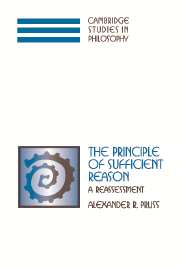Book contents
- Frontmatter
- Contents
- Acknowledgments
- Part I The Principle of Sufficient Reason and the Causal Principle
- Part II Objections to the PSR
- Part III Justifications of the PSR
- 11 Self-Evidence
- 12 Three Thomistic Arguments
- 13 Modal Arguments
- 14 Is the Universe Reasonable?
- 15 Explanation of Negative States of Affairs
- 16 The Puzzle of the Everyday Applicability of the PSR
- 17 Inference to the Best or Only Explanation
- 18 Inductive Skepticism
- 19 The Nature of Possibility
- 20 Conclusions
- Bibliography
- Index
15 - Explanation of Negative States of Affairs
Published online by Cambridge University Press: 27 July 2009
- Frontmatter
- Contents
- Acknowledgments
- Part I The Principle of Sufficient Reason and the Causal Principle
- Part II Objections to the PSR
- Part III Justifications of the PSR
- 11 Self-Evidence
- 12 Three Thomistic Arguments
- 13 Modal Arguments
- 14 Is the Universe Reasonable?
- 15 Explanation of Negative States of Affairs
- 16 The Puzzle of the Everyday Applicability of the PSR
- 17 Inference to the Best or Only Explanation
- 18 Inductive Skepticism
- 19 The Nature of Possibility
- 20 Conclusions
- Bibliography
- Index
Summary
THE ARGUMENT
Here is a pattern of explanation we all accept, which was already met with in Section 3.4: “Why did the yogurt fail to ferment? It failed to ferment because none of the usual explanations of fermentation, namely, the presence of bacteria, were there to explain it, and there was no unusual cause. Why did the dog not bark? It did not bark because no stranger approached it and none of the other possible causes of barking caused it to bark.” These are perfectly fine explanations, and they are not elliptical for longer explanations, though of course they are not ultimate explanations since one may ask why no stranger approached the dog.
In these explanations, we explain a negative state of affairs by noting that the positive state of affairs that it is the denial of lacked an explanation. But now observe that this form of explanation presupposes a PSR, at least for positive states of affair, for if such a PSR does not hold, then one has failed to explain the negative state of affairs. If it is possible that a dog should bark without cause, then in saying that there was no cause for the dog to bark we have not explained why the dog did not bark. We may have explained why a nonbrute barking did not occur, but we have not explained why a brute, or unexplained, barking did not occur.
Information
- Type
- Chapter
- Information
- The Principle of Sufficient ReasonA Reassessment, pp. 252 - 253Publisher: Cambridge University PressPrint publication year: 2006
